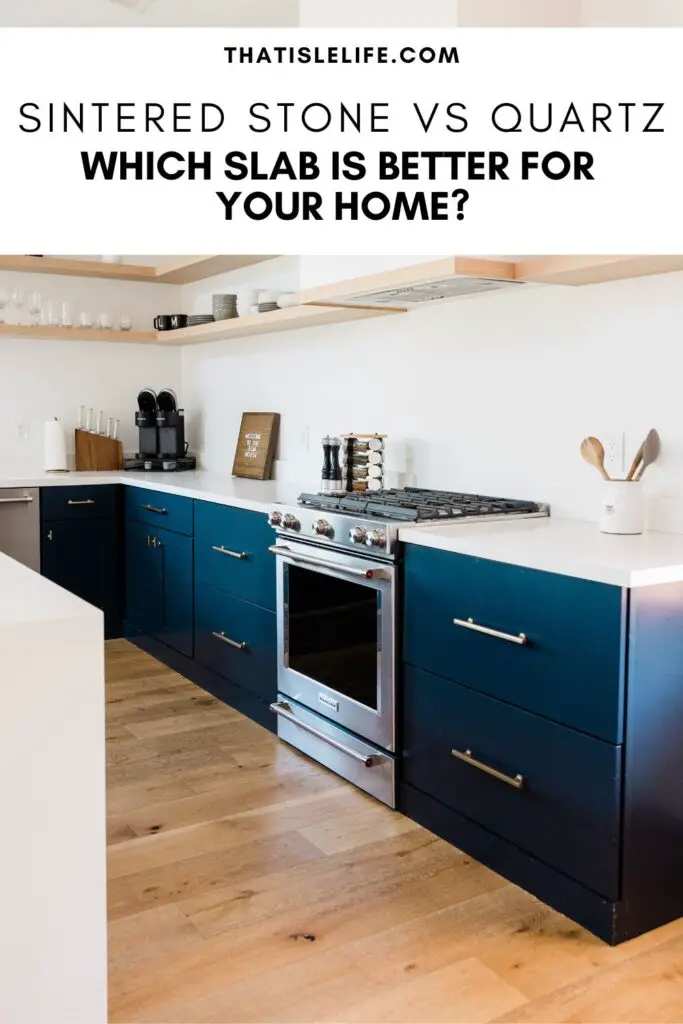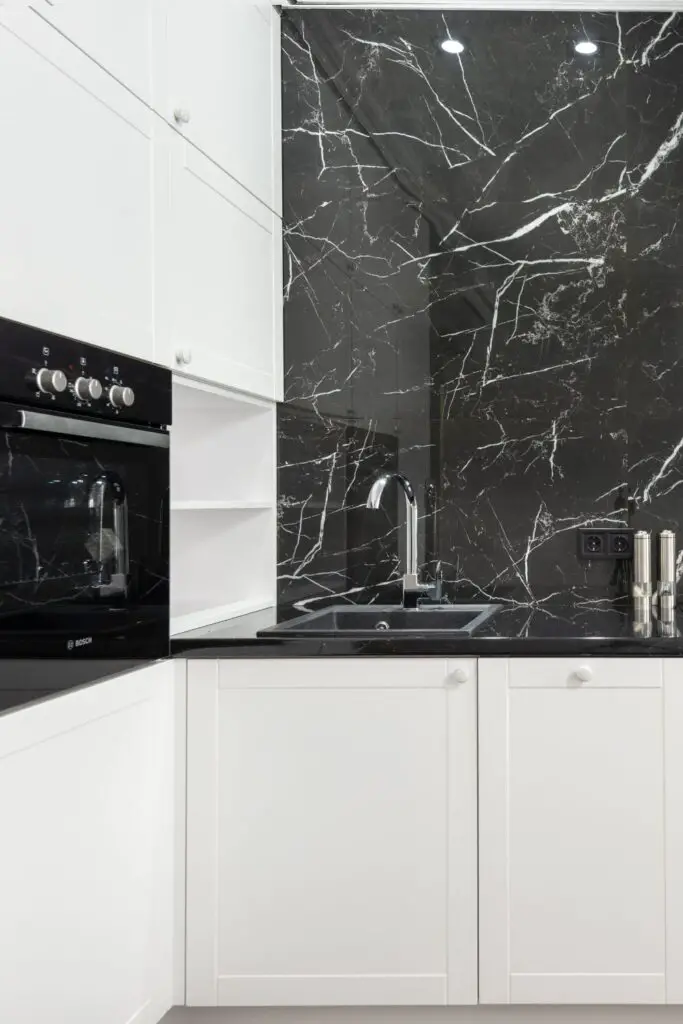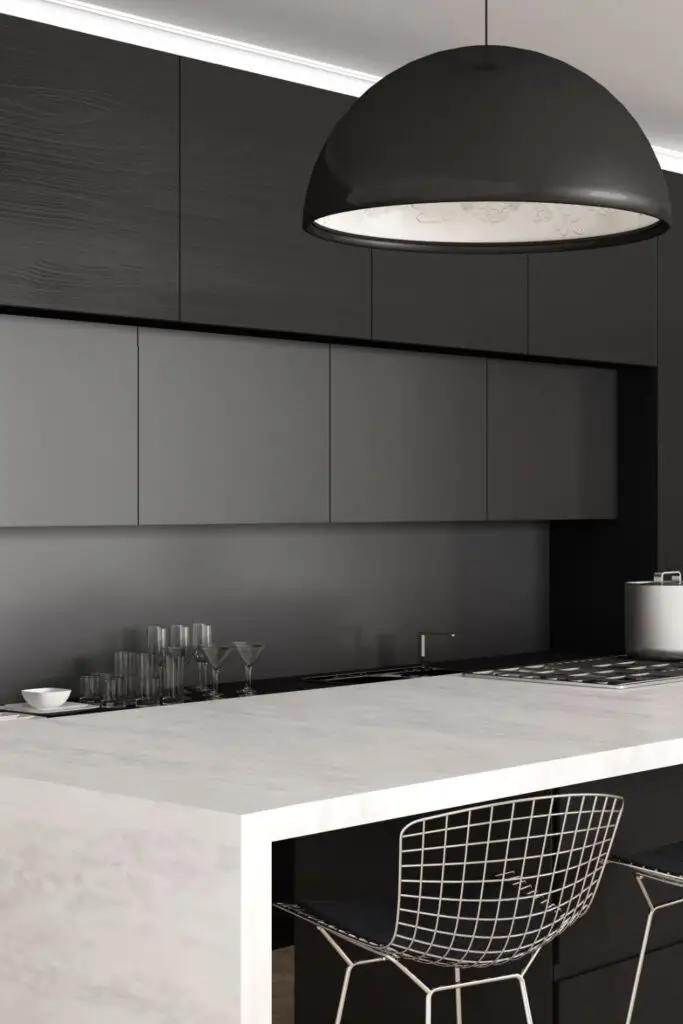Can’t decide between sintered stone vs quartz? Both are beautiful engineered stones that are durable and easy to maintain. So, which option is better for your home? Keep reading to find out the pros and cons of sintered stone vs quartz.
When it comes to engineered or manmade stones, quartz is a crowd favourite.
People love using quartz, especially for kitchen countertops because they not only look beautiful, but they’re also durable and easy to clean and maintain.
However, there is a new and improved engineered stone in the market – sintered stone.
At first glance, sintered stone and quartz look alike.
They even share a few common characteristics such as durability and easy maintenance.
Despite their similarities, there is one stone that’s slightly superior to the other.
Read on to discover the key differences between sintered stone vs quartz.
In this post, I will share everything you need to know about sintered stone vs quartz – what it is, its composition and uses, and the pros and cons of each stone.

Related to Sintered stone Vs Quartz:
- Quartz vs Marble – Which is the better option for my kitchen?
- Dolomite vs Granite: Which Is Better For Kitchen Countertops?
- Travertine vs Marble – What’s the difference and which is the better option for my home?
What is sintered stone?

What it is: An engineered stone made completely from natural minerals
How it’s made: First, natural minerals are carefully selected for quality, colour, and texture before being heated under extreme heat and pressure to form a solid mass that is extremely durable. This process is known as sintering. After the mass is formed, patterns or veins are printed on the slab.
Texture and finish: Sintered stone comes in two types of finishes (high gloss and smooth matte. Both are smooth to the touch.
Colour: A wide variety of colours are available
Pattern: A wide variety of patterns are available. Sintered stone slabs can mimic marble, terrazzo, granite, and more.
Uses: Kitchen countertops, worktops, furniture, flooring, shelves, wall cladding
Cleaning instructions: All you need is warm water and mild soap for day-to-day cleaning. A nonabrasive cleaner works for some stubborn spills.
Maintenance: Day-to-day cleaning is sufficient. No sealing is required.
Pros of sintered stone
Extremely durable
Since sintered stone is an engineered stone, it is extremely durable and nonporous. Like quartz, it is resistant to water, stains, scratches, cracks, and chips. Sintered stone also doesn’t react with chemicals. It scores a 7 on the Mohs hardness scale, which makes it a harder stone than quartz.
Heat-resistant
Since sintered stone doesn’t contain any resin in it, it is heat-resistant. Setting a hot pan or pot on a sintered stone will not cause any damage to the slab.
UV-resistant
Sintered stone is also UV-resistant and its colour will not fade or discolour even when exposed to sunlight over time. This makes it an excellent option for outdoor use.
Looks natural and organic
Sintered stone uses digital imaging technology to print a pattern on its surface. Popular sintered stone patterns mimic the appearance of natural stone surfaces such as marble. The technology used helps to make the stone patterns or veins look realistic, natural, and organic.
Easy to clean and maintain
Similar to quartz, sintered stone is very easy to clean and maintain. They do not require any sealing or waxing and can be easily cleaned with water, mild soap, and a sponge.
100% Natural
Sintered stone is made out of 100% natural materials. It does not contain any resin, unlike quartz.
Cons of sintered stone
Expensive
The cost of sintered stone runs from $60-$100 per square foot. Prices vary depending on the stone’s quality, design, brand, location, and installation difficulty. Overall, the cost of sintered stone is higher than quartz.
Patterns are printed on the top surface only
The pattern on the sintered surface is only visible on the top surface. This is different from quartz, where you’ll be able to see the pattern running through the sides as well.
What is quartz?

What it is: Quartz refers to a mineral of many varieties that consists primarily of silica, or silicon dioxide. However, engineered quartz is made from roughly 90% natural quartz and 10% poly resin.
How it’s made: Engineered quartz is manufactured by grinding natural quartz and other natural stone or recycled industrial wastes like ceramic and glass and binding them together with resin.
Texture: Wide variety of textures from polished to honed
Pattern: Wide variety of patterns from flecked, smooth, veins to mimic natural stone
Colour: Wide variety of colours. Natural shades especially bright whites are very popular.
Uses: Kitchen countertops and backsplashes, bathroom countertops, indoor floors
Cleaning instructions: All you need is warm water and mild soap for day-to-day cleaning. A nonabrasive cleaner works for some stubborn spills.
Maintenance: Day-to-day cleaning is sufficient. No sealing is required.
Pros of quartz
Durable and nonporous
Since quartz is an engineered stone, it is nonporous. This means it is resistant to stains, scratches, and acid abrasion. It also will not chip or crack. Thanks to its hardiness, quartz doesn’t suffer from obvious tear and wear marks over the years.
Wide variety to choose from
Engineered quartz comes in a wide variety of colours, textures, and patterns. Plus, with so many brands available in the market, it is easy to source and purchase different types of engineered quartz.
Consistent in colour and pattern
Since engineered quartz is manmade, they are usually consistent in colour and pattern. The pattern also travels through the slab, which means you can see the design running through the side of the countertop. This trait is perfect for people who love cohesion and uniformity.
Easy to clean and maintain
Engineered quartz is well-loved because they are so easy to clean and maintain! They do not require any sealing or waxing and can be easily cleaned with water, mild soap, and a sponge.
Affordable
Engineered quartz run between $55 to $75 per square foot installed. Prices vary based on colour choices, type of brand, sizes, configurations, and location. If you only need a small piece of quartz, consider going to the scrapyard as you may be able to score half-priced leftover pieces from someone else’s project!
Cons of quartz
Not heat-resistant
Engineered quartz is not heat-resistant because it contains resin, which can only withstand approximately 150 degrees. Placing very hot materials on a quartz countertop without a trivet will damage the surface.
Not UV-resistant
Additionally, engineered quartz is not UV-resistant because the resin is vulnerable to sunlight. As a result, quartz is not suitable for outdoor use as the colour may fade or discolour if exposed to sunlight over time.
Not as unique as natural stone
Compared to natural stone, engineered quartz lacks variations in patterning and veining. Therefore, the pattern or veins may look more generic and less realistic.
Sintered stone or quartz – which is better for your home?
After researching both engineered stones, I’m on Team Sintered Stone!
If you have the budget, I highly recommend selecting sintered stone over quartz. Despite their similarities, it’s obvious that sintered stone is the superior sister.
Sintered stone is a lot more durable, looks beautiful and natural, and can be used indoors and outdoors.
I’m definitely considering sintered stone for my laundry room countertops and backsplash. What’s your pick – sintered stone or quartz?
Are you still searching for the best natural or engineered stone for your home? Check out these blog posts before you decide:

